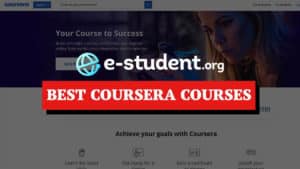
8 Best Coursera Courses You Can Take for Free
These are the very best Coursera courses from the e-learning giant’s massive catalog of free courses.
This academic specialization in Spanish for beginners aims to offer a comprehensive, rigorous, and holistic entry point to the language. Read my review to see if it might be a good fit for you.
E-student.org is supported by our community of learners. When you visit links on our site, we may earn an affiliate commission.
4.3 / 5
The UC Davis "Learn Spanish - Basic Spanish Vocabulary" Specialization on Coursera is a rigorous beginner-level course taught by Dr. Robert Blake, a Spanish Linguistics professor. It offers an academic learning approach focusing on grammar, cultural insights, and practical uses of the language. The course includes real tests and reviews graded as you progress through the activities, ending with a final project you must create to complete the learning path. The course provides a clear and cohesive learning experience that needs to be followed with commitment and rigor.
Coursera is one of the most prestigious educational platforms online, offering courses, specializations, and degrees in many disciplines from leading universities worldwide. At the end of the courses, you can get a certificate issued by Coursera and the host University that offers the course. One of Coursera’s Specializations is “Learn Spanish: Basic Spanish Vocabulary,” a beginner Spanish course offered by the University of California Davis and taught in English by Dr. Robert Blake. In this review, we’ll have a closer look at what this program has to offer those looking to learn Spanish – read on to see if it might be a good fit for your learning needs!
This Spanish learning program follows a formal structure shared across all Coursera courses, which resembles going to class, listening to a teacher, doing assessments, and being graded. This is a great option for learners who want to engage rigorously and intensively in learning Spanish.
The program is taught by Dr. Robert Blake, a professor of Spanish linguistics at UC Davis and director of the Davis Language Center. In 2004, he joined the North American Academic of the Spanish Language and the Royal Spanish Academy.

Every course has an outstanding and clear structure of pedagogical elements, such as videos, texts, activities, assessments, quizzes, and reviews. This gives you concise information about how to use the platform and the order of activities you need to follow to learn effectively. Each course is divided into modules that take 3 to 4 hours to complete. Every module has different activities you must follow in a single linear path. Different from other online language-learning services or apps, where you can jump across topics, levels of difficulties, or sessions, this course is designed as a progressive learning path that guides you from one activity to the next. Although this gives less flexibility, it might be the best option to approach learning Spanish comprehensively, coherently, and cohesively.

Learning activities inside modules are varied and target the development of all linguistic skills you must have to become fluent in the language (speaking, reading, and listening). In this course, only watching videos or linking images to concepts becomes secondary, so you must be actively engaged and committed to completing all activities to progress along your learning path.
Every module starts with an introductory video where Dr. Blake describes the goals and general prospects of the sessions. It is followed by videos and readings introducing new vocabulary and concludes with quizzes and reviews. Then, you proceed to grammar activities that follow similar activities from the first part. Later you continue to a set of activities called “Perspectivas”. Here, you will be introduced to videos about cultural aspects of Spanish-speaking countries, focusing on daily-life activities, popular places, or daily life situations that you might encounter in Spanish-speaking contexts.

Reading activities are not part of the platform itself, but rather, they are embedded through a hyperlink that will take you to another service called ICultura. Here, you will have an interactive space that resembles another kind of language learning service. In this platform, you will be guided through different activities where you will read instructions, match words with pictures, fill in blanks with concepts, or associate words with meanings. This complements the teaching videos greatly as it gives you a more holistic and entertaining way of making new associations between words, images, and meanings.


Other activities in Coursera’s platform include discussion prompts, where you will be asked to describe situations from your experience, such as where you live or what you like to do. This comes after watching a previous video where a native speaker exemplified how to talk about a certain topic.


Coursera’s grading system is quite similar to those of other academic institutions. Every module has a final test that you need to pass with over 80% of correct answers. This means that, in order to progress to the next module, you need to show that you effectively learned the topics of the module. This will ensure you a thorough understanding of new information and your skill development.
Tests are often composed of multiple-choice and filling-the-blank questions. Coursera takes the testing very seriously, and you need to agree on the Coursera Honor Code before submitting your answers. This academic policy and code of conduct assures Coursera that you are aware of and follow standards that keep the integrity of learning when undertaking Coursera platform experiences. In other words, if you submit work that is not yours, you might face the permanent failure of the course and the deactivation of your account.

After you complete all the activities, reviews, and assessments and present your final project, you will be graded and receive a certificate from Coursera and the corresponding University that you can use to add to your professional profile and CV. This might be one of the main advantages of taking this Spanish course if compared to other online services, as it will grant you proof that you can effectively use Spanish for your professional or educational activities.
This course offers a 7-day free trial that grants you unlimited access to all courses in the Specialization. You can cancel anytime without penalties if you do it before the free trial ends. After this, you can continue the course by paying $59 monthly for Coursera Plus or $49 for only the individual course.
This Learn Spanish Specialization is very clear about the targeted audiences. It is designed for beginners who want to have a comprehensive, rigorous, and holistic entrance to the Spanish Language. However, I would say that since this is a more academic Spanish course, intermediate learners can benefit from it, and more if they are coming from more informal ways of learning. The requirement of passing tests and doing a lot of writing can be beneficial even if the basic knowledge is already learned.
UCA Davis Specialization “Learn Spanish: Basic Spanish Vocabulary,” offered through Coursera, is a great course with relevant knowledge of the language’s structures and practical uses with in-depth explanations and the possibility of being graded and certified by a real university. This is a great option for those Spanish learners urged to feel that they are being taught in a structural and scheduled way. This can be a great option for those learners who struggle to find motivation to invest time and concentration in learning Spanish.


These are the very best Coursera courses from the e-learning giant’s massive catalog of free courses.

Here’s a handy list of the most valuable skills you can learn online through online courses, video tutorials, and free online resources.

Trying to master your spray-can technique or have an interest in abstract art? Find out in review if Futura’s MasterClass is for you.